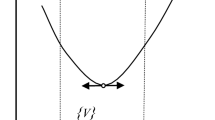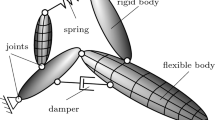Problems of parametric optimization of rod structure stated in terms of the nonlinear programming problem are considered. Use is made of the method of projection of the gradient of the cost function onto the surface of active constraints while eliminating the residuals in the violated constraints. The equivalent Householder transformations are proposed for the governing equations of the optimization method. They ensure the computational efficiency of the algorithm based on the gradient method. In addition, the equivalent Givens transformations are also proposed for solving the equations of the method. They ensure, in the cases described in this article, the acceleration of the iterative process by reducing the amount of computation. The reliability of the optimal solutions obtained using the proposed modification of the gradient method is confirmed by comparing the results of optimization of rod systems. The efficiency of the proposed improvement of the optimization method is also confirmed by the obtained absolute values of the maximum residuals in the constraints in a small number of iterations.
Similar content being viewed by others
References
V. I. Gulyaev, V. A. Bazhenov, and V. L. Koshkin, Optimization Methods in Structural Mechanics [in Russian], Kyiv (1989).
A. V. Alekseytsev, “Evolutionary optimization of steel trusses with the nodal joints of rods,” Mag. Civil Eng., 40, No. 5, 28–37 (2013).
D. Bindel, J. Demmel, W. Kahan, and O. Marques, “On computing Givens rotations reliably and efficiently,” ACM Trans. Math. Soft., 28, No. 2, 206–238 (2002).
N. P. Crowder, R. S. Denbo, and J. M. Mulvey, “Reporting computational experiments in mathematical programming,” Math. Progr., No. 15, 316–329 (1978).
S. Czarnecki, “Optimal structural design using a genetic algorithm,” Theor. Found. Civil Eng., No. VII, 201–210 (1999).
S. Czarnecki, “Multithreaded genetic program in truss shape optimization,” Theor. Found. Civil Eng., No. VIII, 556–560 (2000).
M. W. Dobbs and R. B. Nelson, “Application of optimality criteria to automated structural design,” AIAA J., 14, No. 10, 1436–1443 (1976).
G. V. Filatov, “Mass optimization of a compressed cylindrical shell with limited life,” Int. Appl. Mech., 42, No. 3, 331–335 (2006).
G. H. Golub and C. F. Van Loan, Matrix Computations, The Johns Hopkins University Press, Baltimore (1996).
E. J. Haug and J. S. Arora, Applied Optimal Design: Mechanical and Structural Systems, John Wiley & Sons, New York (1979).
K. H. Huebner, D. L. Dewhirst, D. E. Smith, and T. G. Byrom, The Finite Element Method for Engineers, John Wiley & Sons, New York (2001).
A. Kibkalo, M. Lebedeva, and M. Volkov, “Methods of parametric optimization of thin-walled structures and parameters which influence on it,” MATEC Web of Conf., Vol. 53, No. 01051 (2016).
V. L. Koshkin and I. O. Serpak, “Optimal design of flexible rod structural members,” Strength of Materials, No. 25, 834–840 (1993).
I. Peleshko and V. Yurchenko, “An improved gradient-based method to solve parametric optimisation problems of the bar structures,” Stren. Mat. Theory Struct.: Scientific-and-Technical Collected Articles, KNUBA, Kyiv, No. 104, 265–288 (2020).
A. V. Perelmuter and V. V. Yurchenko, “Parametric optimization of steel shell towers of high-power wind turbines,” Proc. Eng., No. 57, 895–905 (2013).
V. O. Permyakov, V. V. Yurchenko, and I. D. Peleshko, “An optimum structural computer-aided design using hybrid genetic algorithm,” in: Proc. Int. Conf. on the Progress in Steel, Composite and Aluminium Structures, Taylor&Francis, London (2006), pp. 819–826.
W. H. Press, S. A. Teukolsky, W. T. Vetterling, and B. P. Flannery, Givens Method. Numerical Recipes: the Art of Scientific Computing. 3rd ed., Cambridge University Press, Cambridge (2007).
G. V. Reklaitis, A. Ravindran, and K. M. Ragsdell, Engineering Optimization. Methods and Applications, John Wiley & Sons, New York (2006).
P. Rizzi, The Optimization of Structures with Complex Constraints Via a General Optimality Criteria Method, PhD Thesis, Stanford University, CA, Palo Alto (1976).
L. A. Schmit and H. A. Miura, “New structural analysis. Synthesis capability. ACCESS 1,” AIAA J., 14, No. 5, 661–671 (1976).
O. A. Sergeyev, V. G. Kiselev, and S. A. Sergeyeva, “Optimal design of 3D frame structures taking into account the stress and multiple natural frequency constraints,” Mag. Civ. Eng., 61, No. 1, 74–81 (2016).
I. N. Serpik, A. V. Alekseytsev, P. Yu. Balabin, and N. S. Kurchenko, “Flat rod systems: optimization with overall stability control,” Mag. Civ. Eng., 76, No. 8, 181–192 (2017).
E. Kuci, F. Henrotte, P. Duysinx, and C. Geuzaine, “Design sensitivity analysis for shape optimization based on the Lie derivative,” Comp. Meth. Appl. Mech. Eng., No. 317, 702–722 (2017).
J. H. Wilkinson and C. Reinsch, Handbook for Automatic Computation, Vol. II: Linear Algebra, Springer-Verlag, Berlin (1971).
V. Yurchenko and I. Peleshko, “Improved gradient projection method for parametric optimisation of bar structures,” Mag. of Civ. Eng., 98, No. 6, Article No. 9812 (2020).
V. V. Yurchenko and I. D. Peleshko, “Searching for optimal pre-stressing of steel bar structures based on sensitivity analysis,” Arch. Civ. Eng., 66, No. 3, 525–540 (2020).
Author information
Authors and Affiliations
Corresponding author
Additional information
Translated from Prikladnaya Mekhanika, Vol. 57, No. 4, pp. 78–95, July–August 2021.
Rights and permissions
About this article
Cite this article
Peleshko, I.D., Yurchenko, V.V. Parametric Optimization of Metal Rod Structures Using the Modified Gradient Projection Method. Int Appl Mech 57, 440–454 (2021). https://doi.org/10.1007/s10778-021-01096-0
Received:
Published:
Issue Date:
DOI: https://doi.org/10.1007/s10778-021-01096-0




